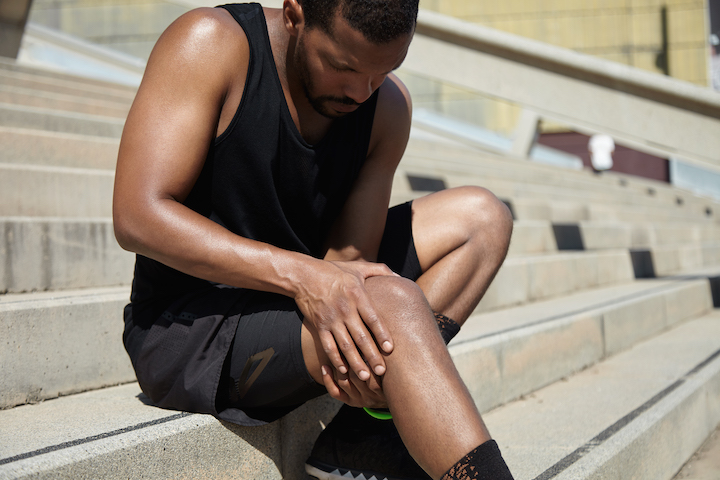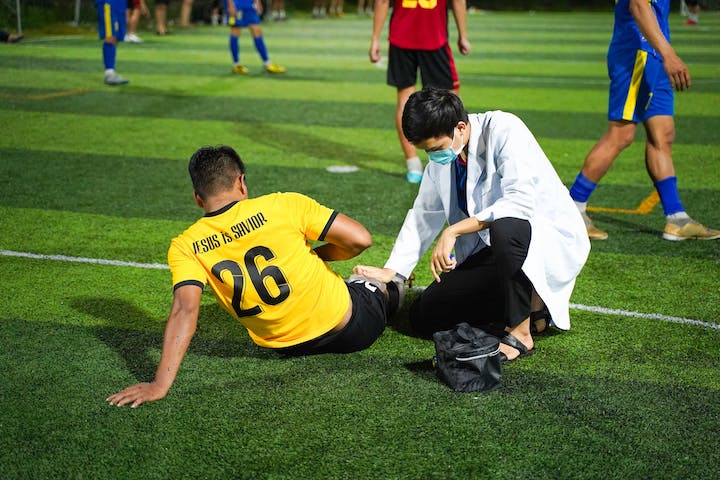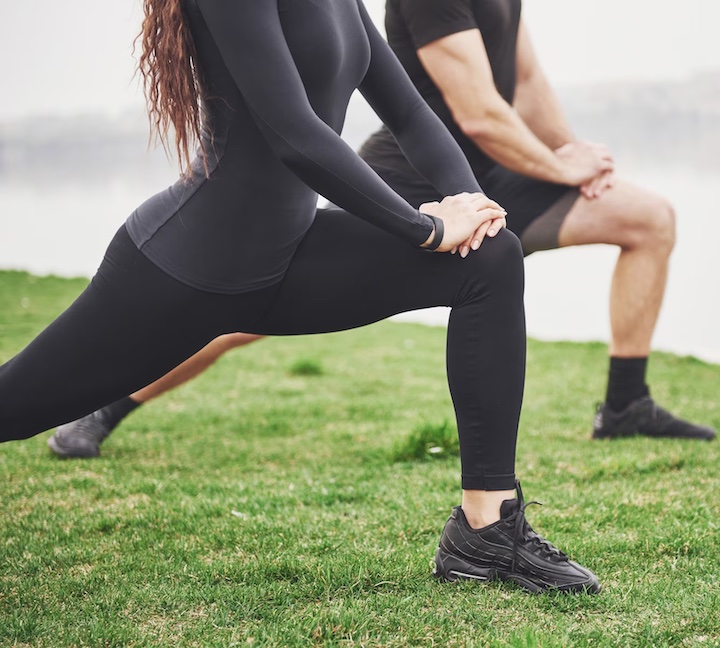Participating in sports and physical activities can be an excellent way to stay fit and healthy. However, it also comes with the risk of injuries, particularly to the knees. Knee sports injuries are painful and can lead to long-term complications if not appropriately managed.
Whether you’re a professional athlete or enjoy sports for leisure, it’s crucial to understand how to prevent, diagnose, treat, and recover from knee sports injuries.
Knee injuries are common among athletes and sports enthusiasts and can occur for various reasons. Understanding the different types of knee sports injuries, their causes, and the knee joint anatomy is important for preventing and treating them effectively.
Ligament tears are a common type of knee sports injury that can occur due to sudden twisting or impact on the knee joint. The anterior cruciate ligament (ACL), medial collateral ligament (MCL), and lateral collateral ligament (LCL) are the three main ligaments in the knee that are frequently injured. Symptoms of a ligament tear include pain, swelling, instability, and difficulty bearing weight on the affected leg.
The menisci are two C-shaped pieces of cartilage that act as shock absorbers in the knee joint. A meniscus tear can happen due to twisting or hyperflexion of the knee and can cause pain, swelling, and locking of the joint. Meniscus tears are more common in contact sports such as football and basketball.

Photo Credit: Way Home Studios, Envato Elements Photos
Patellofemoral pain syndrome, also known as runner’s knee, is a condition that results in pain under the kneecap. It can occur due to overuse, muscle imbalances, or a direct blow to the knee. The pain may increase with certain activities, such as running, jumping, or squatting, accompanied by a grinding sensation or popping noise in the knee.
The knee joint comprises four main bones – the femur, tibia, fibula, and patella. It is supported by several ligaments, tendons, and muscles that help in its movement and stability. The knee joint is susceptible to injuries due to its complex structure and involvement in weight-bearing activities.
Knee injuries can occur for several reasons, including improper technique, overuse, lack of conditioning, or direct blows to the knee. Athletes participating in high-impact sports such as football, basketball, and soccer are at a higher risk of knee injuries. Incidents such as falls, collisions, or twists can also lead to knee injuries.
Preventing knee sports injuries is crucial for athletes and sports enthusiasts alike. With the right techniques, you can significantly reduce the risk of knee injuries. Here are some tips and strategies:
Warm-up exercises are essential to prepare your muscles and joints for physical activity. A good warm-up routine will gradually increase your heart rate and improve blood flow, which helps reduce the risk of injury. Prioritise stretching exercises that target the leg muscles and joints, including the hamstrings, calves, and quads. Performing dynamic stretches such as squats, lunges, leg swings, and hip circles can also help improve flexibility and range of motion.
Practising proper techniques is essential to prevent knee sports injuries. Make sure you use correct body posture and alignment when performing sports activities such as running, jumping or landing. Avoid pivoting and twisting motions that can put undue stress on your knee joint. For activities that require sudden stops and changes of direction, such as basketball or soccer, be sure to pivot on the ball of your foot and avoid planting your foot flat on the ground, which can increase your risk of injury.
Knee braces can provide additional support and help prevent knee injuries. Different braces are available, including prophylactic braces designed to protect knees during sports activities and rehabilitative braces designed to support knees while they heal from an injury. Consult with a medical professional to determine which type of brace will work best for you.
Maintaining proper fitness levels is key to preventing knee sports injuries. Ensure you have adequate muscle strength, flexibility, and endurance for your chosen sport. Consider combining cardio and strength training exercises to improve your fitness levels. If you are new to a sport or activity, start slowly and gradually increasing your training sessions’ intensity and duration.
Incorporating these tips into your routine can significantly reduce the risk of knee sports injuries. Remember to consult your doctor or physiotherapist before starting any new fitness regimen or if you experience knee pain or discomfort.
When treating knee sports injuries, the first step is accurate diagnosis. Depending on the severity and type of injury, doctors may perform imaging tests such as X-rays, MRIs, and CT scans. This will help them determine the extent of the damage and create a customised treatment plan.

Photo Credit: Quyn Phạm, Pexels
RICE Method: One of the most common treatment methods for knee sports injuries is the RICE method. Rest, Ice, Compression, and Elevation can help reduce pain and swelling, allowing the injury to heal. During the rest period, athletes must avoid putting weight on the affected knee and rest it as much as possible. Ice should be applied several times a day to reduce inflammation. Compression with a bandage or brace can help limit swelling. Elevating the knee above the heart level can also reduce swelling and improve blood flow to the area.
Physical Therapy Exercises: As the injury heals, doctors may recommend physical therapy exercises to improve knee strength and mobility. These exercises may include stretching, range of motion activities, and muscle strengthening exercises. Physical therapy can also help athletes regain confidence in their ability to move and develop coping strategies.
Regenerative Therapies: Depending on the severity of the injury, doctors may recommend advanced treatments such as regenerative therapies. These therapies aim to stimulate the body’s natural healing process, encouraging the growth of new tissue and promoting faster recovery. Options may include platelet-rich plasma (PRP) therapy, stem cell therapy, and prolotherapy.
Surgery: In more severe cases, surgery may be necessary to repair the knee joint. This may include procedures such as arthroscopy or knee replacement surgery. Surgery is usually a last resort and reserved for cases where other treatments have failed.
Physical therapy exercises are important to knee sports injury treatment and recovery. These exercises can help improve knee strength, flexibility, and range of motion and reduce the risk of re-injury. Here are a few examples of knee injury exercises:
Remember to consult a doctor or physical therapist before attempting knee injury exercises. It’s important to follow their advice and progress gradually to avoid re-injury.
Recovering from a knee sports injury can be a challenging process, but there are steps you can take to speed up your recovery and get back to your favourite activities. Here are some practical tips to help you recover from a knee injury:
Rehabilitation is critical for recovery and should be approached with patience and commitment. Your doctor or physiotherapist will create a rehabilitation timeline outlining a step-by-step recovery plan. Stick to this timeline and take your time with the process. It may take several weeks or even months to recover from a knee sports injury fully.
While taking it easy in the early stages of recovery is important, staying active is crucial for joint health and can speed up the recovery process. Engage in low-impact activities such as swimming or cycling to maintain your fitness level without putting too much strain on your knee.
As you recover, gradually increase the intensity and frequency of your activities. Consult with your doctor or physiotherapist to ensure that you are not pushing yourself too hard too soon. It’s important to listen to your body and take breaks when needed.

Photo Credit: Standret, Freepik
Your doctor or physiotherapist will prescribe specific exercises to help you recover from your knee sports injury. Doing these exercises regularly is important to build strength and flexibility in your knee joint. Skipping exercises or not doing them properly can delay your recovery.
Proper self-care is important for a smooth recovery. Get enough rest, eat a balanced diet, and stay hydrated. Applying ice or using compression can also help reduce swelling and pain. Avoid activities that cause pain or discomfort, and listen to your body.
By following these tips and working with your healthcare provider, you can recover from a knee sports injury and return to your active lifestyle.
Knee sports injuries refer to injuries that occur during sports activities and affect the knee joint. These injuries can involve the ligaments, meniscus, or other structures in the knee.
Common knee sports injuries include ligament tears (such as ACL tears), meniscus tears, and patellofemoral pain syndrome.
Various factors, including sudden impact, repetitive stress, improper technique, overuse, or accidents during sports activities, can cause knee sports injuries.
Prevention techniques for knee sports injuries include warming up properly before physical activity, using proper technique and form during sports activities, wearing appropriate protective gear, such as knee braces, and maintaining good overall physical conditioning.
Knee sports injuries are typically diagnosed through physical examinations, medical history review, imaging tests (such as X-rays, MRI, or CT scans), and possibly arthroscopy (a minimally invasive procedure to visualise the inside of the knee joint).
Treatment options for knee sports injuries can vary depending on the injury’s severity. They may include conservative measures such as rest, ice, compression, elevation (RICE), physical therapy exercises, bracing, medications, and in some cases, surgery or regenerative therapies.
The recovery time for a knee sports injury can vary depending on the type and severity of the injury and individual factors. Following the recommended rehabilitation timeline and medical advice is important for a safe and successful recovery.
The timing for returning to sports activities after a knee sports injury will depend on the specific injury, the recovery progress, and your healthcare professional’s guidance. It is essential to gradually reintroduce activities and ensure proper conditioning to minimise the risk of re-injury.